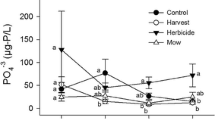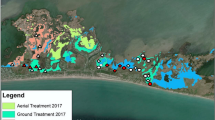Abstract
As a result of water-level regulation, cattails have invaded sedge/grass meadow in all wetlands on Lake Ontario. Even with a change in water-level-regulation to a more natural hydrologic regime, restoration requires methods for active cattail management without the ability to manipulate water depths and without imperiling other vegetation. We conducted replicated studies at a wetland site with an active invasion front in zones of nearly mono-dominant cattail and transitional invasion. We tested various combinations of cutting cattail ramets when carbohydrate reserves were minimized, spraying cut stems with herbicide, slicing rhizomes to mimic tilling, and hand-wicking resprouted ramets with herbicide. We also collected companion environmental data. The most effective treatment in both zones was cutting during the period with reduced rhizome carbohydrates followed by hand-wicking resprouted ramets with herbicide in late summer, which allows the herbicide to be absorbed by the rhizomes. Two years of treatment provide the best results, reducing cattail stem counts and cover by more than 50%, but follow-up applications in ensuing years may be warranted to treat surviving cattails. Given the widespread problem of cattail invasion, these treatments may have broad application in wetlands where water levels cannot be manipulated.


Similar content being viewed by others
References
Ashworth SM (1997) Comparison between restored and reference sedge meadow wetlands in south-central Wisconsin. Wetlands 17:518–527
Ball JP (1990) Influence of substantial flooding depth on cattail control by burning and mowing. Journal of Aquatic Plant Management 28:32–36
Beule JD (1979) Control and management of cattails in southeastern Wisconsin wetlands. Technical Bulletin No. 112, Department of Natural Resources, Madison, WI
Biesboer DD (1984) Seasonal variation in nitrogen fixation, associated microbial populations, and carbohydrates in roots and rhizomes of Typha latifolia (Typhaceae). Canadian Journal of Botany 62:1965–1967
Boers AM, Veltman RLD, Zedler JB (2007) Typha x glauca dominance and extended hydroperiod constrain restoration of wetland diversity. Ecological Engineering 29:232–244
Cole DJ (1985) Mode of action of glyphosate - a literature analysis. In: Grossbard E, Atkinson D (eds) The herbicide glyphosate. Butterworth, London, pp 48–74
Costello DF (1936) Tussock meadows in southeastern Wisconsin. Botanical Gazette 97:610–648
Desgranges JL, Ingram J, Drolet B, Morin J, Savage C, Borcard D (2006) Modelling wetland bird response to water-level changes in the Lake Ontario-St. Lawrence River hydrosystem. Environmental Monitoring and Assessment 113:329–365
Elgersma KJ, Martina JP, Goldberg DE, Currie WS (2017) Effectiveness of cattail (Typha spp.) management techniques depends on exogenous nitrogen inputs. Elementa 5:19. https://doi.org/10.1525/elementa.147
Farrell JM (2001) Reproductive success of sympatric northern pike and muskellunge in an upper St. Lawrence River bay. Transactions of the American Fisheries Society 130:796–808
Farrer EC, Goldberg DE (2009) Litter drived ecosystem and plant community changes in cattail invasion. Ecological Applications 19:398–412
Frieswyk CB, Zedler JB (2007) Vegetation change in Great Lakes coastal wetlands: deviation from the historical cycle. Journal of Great Lakes Research 33:366–380
Friezwyk CB, Johnston CA, Zedler JB (2007) Identifying and characterizing dominant plants as indicator of community condition. Journal of Great Lakes Research 33(special issue 3):125–135
Galatowitsch SM, Anderson NO, Ascher PD (1999) Invasiveness of wetland plants in temperate North America. Wetlands 19:733–755
Gertz AK, Eisenbach J, Walker GK (1994) SEM identification of Michigan cattails, Typha latifolia and Typha angustifoilia, and their hybrid, Typha x glauca. Michigan Botanist 33:27–36
Gertzen EL, Doka SE, Minns CK, Moore JE, Bakelaar C (2012) Effects of water levels and water-level regulation on the supply of suitable spawning habitat for eight fish guilds in the bay of Quinte, Lake Ontario. Aquatic Ecosystem Health and Management 15:397–409
Grossman RB, Reinsch TG (2002) Methods of soil analysis, ch 2. In: Dane JH, Clarke TG (eds) SSSA book series: 5 methods of soil analysis. Soil Science Society of America, Madison
Hall SJ, Zedler JB (2010) Constraints on sedge meadow self-restoration in urban wetlands. Restoration Ecology 18:671–680
Hellsten S, Dieme C, Mbengue M, Janauer GA, den Hollander N, Pieterse AH (1999) Typha control efficiency of a weed-cutting boat in the Lac de Guiers iin Senegal: a preliminary study on mowing speed and re-growth capacity. Hydrobiologia 415:249–255
IJC (2014) Lake Ontario-St. Lawrence River Plan 2014: protecting against extreme water levels, restoring wetlands, and preparing for climate change. International Joint Commission, Ottawa
Kostecke RM, Smith LM, Hands HM (2004) Vegetation response to cattail management in Cheyenne bottoms, Kansas. Journal of Aquatic Plant Management 42:39–45
Lawrence BA, Lishawa SC, Rodriguez Y, Tuchman NC (2016) Herbicide management of invasive cattail (Typha x glauca) increases porewater nutrient concentrations. Wetlands Ecology and Management 24:457–467
Linde AF, Janisch T, Smith D (1976) Cattail – the significance of growth, phenology, and carbohydrate storage to its control and management. Technical Bulletin No. 94, Department of Natural Resources, Madison
Lishawa SC, Albert DA, Tuchman NC (2010) Water-level decline promotes Typha x glauca establishment and vegetation change in Great Lakes coastal wetlands. Wetlands 30:1086–1096
Lishawa SC, Lawrence BA, Albert DA, Tuchman NC (2015) Biomass harvest of invasive Typha promotes plant diversity in a Great Lakes coastal wetland. Restoration Ecology 23:228–237
Mallik AU, Wein RW (1986) Response of a Typha marsh community to draining, flooding, and seasonal burning. Canadian Journal of Botany 64:2136–2143
Nelson NF, Dietz RH (1966) Cattail control methods in Utah. Publication No. 66-2, Utah State Department of Fish and Game, Vernal
Newman S, Schuette J, Grace JB, Rutchey K, Fontaine T, Reddy KR, Pietrucha M (1998) Factors influencing cattail abundance in the northern Everglades. Aquatic Botany 60:265–280
NOAA (2012) Great Lakes water levels dashboard. National Oceanic and Atmospheric Administration. https://www.glerl.noaa.gov/data/dashboard/GLWLD.html
Osland MJ, Gonzalez Z, Richardson CJ (2011) Restoring diversity after cattail expansion: disturbance, resilience, and seasonality in a tropical dry wetland. Ecological Applications 21:715–728
Ponzio KJ, Miller SJ, Lee MA (2004) Long-term effects of prescribed fire on Cladium jamaicense Crantz and Typha domingensis Pers. densities. Wetlands Ecology and Management 12:123–133
Sojda RS, Solberg KL (1993) Management and control of cattails. U.S. Fish and Wildlife Service Leaflet 3.4.13
Steenis JH, Smith LP, Cofer HP (1959) Studies on cattail management in the northeast. Transactions of the Northeast Wildlife Conference 10:149–155
Storer DA (1984) A simple high sample volume ashing procedure for determining soil organic matter. Soil Science Plant Analysis 15:759–772
Tian H, Xu X, Miao S, Sindhoj E, Beltran BJ, Pan Z (2010) Modeling ecosystem responses to prescribed fire in a phosphorus-enriched Everglades wetland: I. phosphorus dynamics and cattail recovery. Ecological Modelling 221:1252–1266
Toner J, Farrell JM, Mead JV (2010) Muskrat abundance responses to water-level regulation within freshwater coastal wetlands. Wetlands 30:211–219
Travis SE, Marburger JE, Windels S, Kubatova B (2010) Hybridization dynamics of invasive cattail (Typhaceae) stands in the western Great Lakes region of North America: a molecular analysis. Journal of Ecology 98:7–16
Travis SE, Marburger JE, Windels S, Kubatova B (2011) Clonal structure of invasive cattail (Typhaceae) stands in the upper midwest region of the US. Wetlands 31:221–228
Vaccaro LE, Bedford BL, Johnston CA (2009) Litter accumulation promotes dominance of invasive species of cattails (Typha spp.) in Lake Ontario wetlands. Wetlands 29:1036–1048
van der Valk AG (1986) The impact of litter and annual plants on recruitment from the seed bank of a lacustrine wetland. Aquatic Botany 24:13–26
van der Valk AG, Davis CB (1978) The role of seed banks in the vegetation dynamics of prairie glacial marshes. Ecology 59:322–335
Weller MW (1975) Studies of cattail in relation to management for marsh wildlife. Iowa State Journal of Research 49:383–412
Wilcox DA (2012) Response of wetland vegetation to the post-1986 decrease in Lake St. Clair water levels: seed-bank emergence and beginnings of the Phragmites australis invasion. Journal of Great Lakes Research 38:270–277
Wilcox DA, Ray G (1989) Using living mat transplants to restore a salt-impacted bog (Indiana). Restoration and Management Notes 7(1):39
Wilcox DA, Xie Y (2007) Predicting wetland plant community responses to proposed water-level-regulation plans for Lake Ontario: GIS-based modeling. Journal of Great Lakes Research 33:751–773
Wilcox DA, Xie Y (2008) Predicted effects of proposed new regulation plans on sedge/grass meadows of Lake Ontario. Journal of Great Lakes Research 34:745–754
Wilcox DA, Apfelbaum SI, Hiebert RD (1984) Cattail invasion of sedge meadows following hydrologic disturbance in the Cowles bog wetland complex, Indiana dunes National Lakeshore. Wetlands 4:115–128
Wilcox DA, Kowalski KP, Hoare HL, Carlson ML, Morgan HN (2008) Cattail invasion of sedge/grass meadows in Lake Ontario: photointerpretation analysis of sixteen wetlands over five decades. Journal of Great Lakes Research 34:301–323
Wisheu IC, Keddy PA (1992) Competition and centrifugal organization of plant communities: theory and tests. Journal of Vegetation Science 3:147–156
Woo I, Zedler JB (2002) Can nutrients alone shift a sedge meadow towards dominance by the invasive Typha x glauce? Wetlands 22:509–521
Yetka LA, Galatowitsch SM (1999) Factors affecting revegetation of Carex lacustris and Carex stricta from rhizomes. Restoration Ecology 7:162–171
Acknowledgments
We thank Brad Mudrzynski, John Bateman, and Alexander Healy for assistance in setting up the treatment plots, Taylor Ouderkirk for taking water-table and soil-moisture measurements, Brad Mudrzynski for statistical advice, and John Bateman for preparing tables and figures. Suggestions made by two anonymous reviewers and the Associate Editor are greatly appreciated.
Author information
Authors and Affiliations
Corresponding author
Rights and permissions
About this article
Cite this article
Wilcox, D.A., Buckler, K. & Czayka, A. Controlling Cattail Invasion in Sedge / Grass Meadows. Wetlands 38, 337–347 (2018). https://doi.org/10.1007/s13157-017-0971-8
Received:
Accepted:
Published:
Issue Date:
DOI: https://doi.org/10.1007/s13157-017-0971-8




